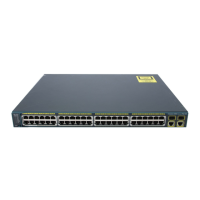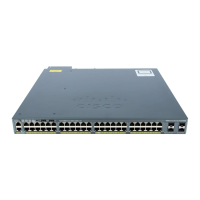When a stack member leaves the stack, spanning-tree reconvergence occurs within the stack (and possibly
outside the stack). The remaining stack member with the lowest stack port ID becomes the stack root.
If the stack master fails or leaves the stack, the stack members elect a new stack master, and all stack members
change their switch IDs of the spanning trees to the new master switch ID.
Interoperability with IEEE 802.1D STP
A switch running MSTP supports a built-in protocol migration mechanism that enables it to interoperate with
legacy IEEE 802.1D switches. If this switch receives a legacy IEEE 802.1D configuration BPDU (a BPDU
with the protocol version set to 0), it sends only IEEE 802.1D BPDUs on that port. An MSTP switch also can
detect that a port is at the boundary of a region when it receives a legacy BPDU, an MSTP BPDU (Version
3) associated with a different region, or an RSTP BPDU (Version 2).
However, the switch does not automatically revert to the MSTP mode if it no longer receives IEEE 802.1D
BPDUs because it cannot detect whether the legacy switch has been removed from the link unless the legacy
switch is the designated switch. A switch might also continue to assign a boundary role to a port when the
switch to which this switch is connected has joined the region. To restart the protocol migration process (force
the renegotiation with neighboring switches), use the clear spanning-tree detected-protocols privileged
EXEC command.
If all the legacy switches on the link are RSTP switches, they can process MSTP BPDUs as if they are RSTP
BPDUs. Therefore, MSTP switches send either a Version 0 configuration and TCN BPDUs or Version 3
MSTP BPDUs on a boundary port. A boundary port connects to a LAN, the designated switch of which is
either a single spanning-tree switch or a switch with a different MST configuration.
RSTP Overview
The RSTP takes advantage of point-to-point wiring and provides rapid convergence of the spanning tree.
Reconfiguration of the spanning tree can occur in less than 1 second (in contrast to 50 seconds with the default
settings in the IEEE 802.1D spanning tree).
Port Roles and the Active Topology
The RSTP provides rapid convergence of the spanning tree by assigning port roles and by learning the active
topology. The RSTP builds upon the IEEE 802.1D STP to select the switch with the highest switch priority
(lowest numerical priority value) as the root switch. The RSTP then assigns one of these port roles to individual
ports:
• Root port—Provides the best path (lowest cost) when the switch forwards packets to the root switch.
• Designated port—Connects to the designated switch, which incurs the lowest path cost when forwarding
packets from that LAN to the root switch. The port through which the designated switch is attached to
the LAN is called the designated port.
• Alternate port—Offers an alternate path toward the root switch to that provided by the current root port.
• Backup port—Acts as a backup for the path provided by a designated port toward the leaves of the
spanning tree. A backup port can exist only when two ports are connected in a loopback by a point-to-point
link or when a switch has two or more connections to a shared LAN segment.
• Disabled port—Has no role within the operation of the spanning tree.
Consolidated Platform Configuration Guide, Cisco IOS Release 15.2(4)E (Catalyst 2960-X Switches)
252
Information About MSTP

